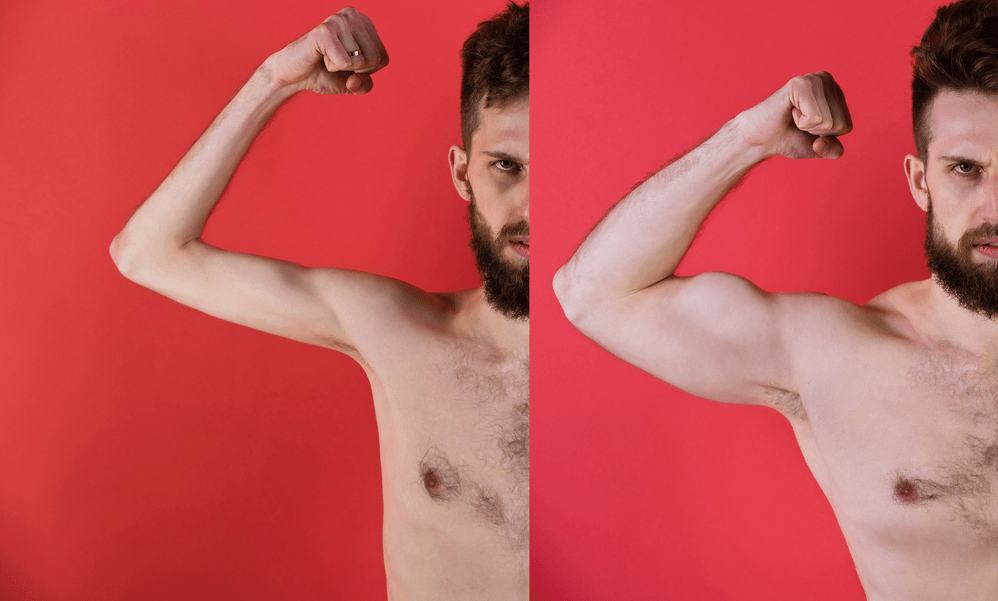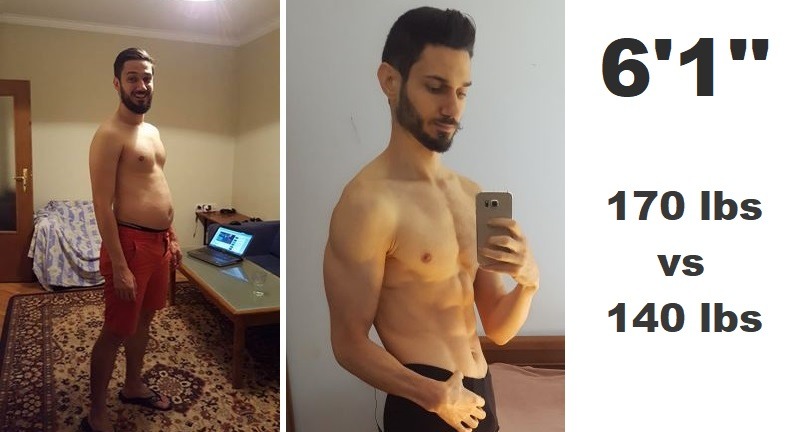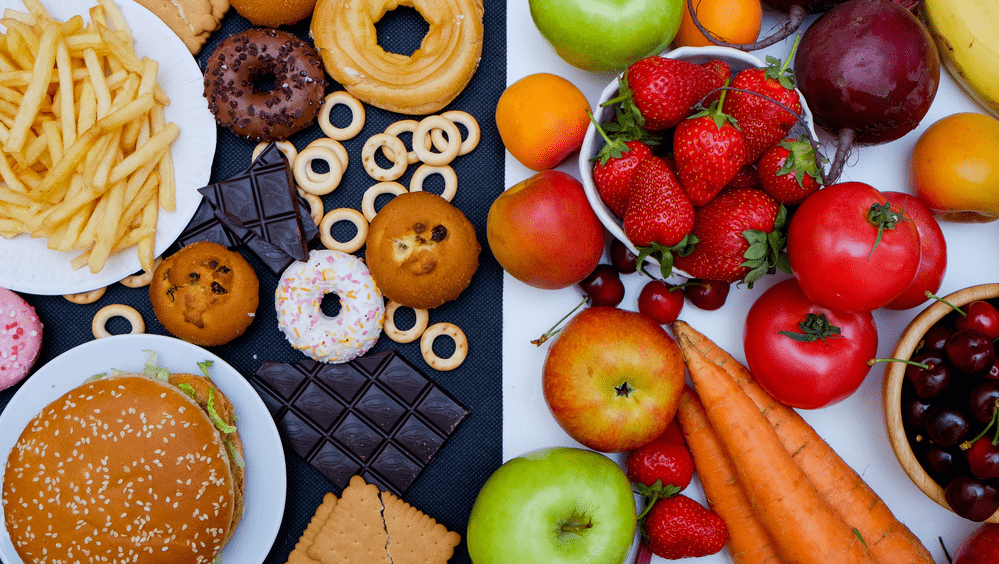How to Gain Weight Fast as an Ultra-Skinny Guy With a Busy Schedule

You fit the true definition of a skinny person: bones sticking out and zero muscle. Your body hasn’t changed much after your teen years. You’ve tried and tried to gain weight and always failed. Now your busy work schedule makes it even harder to get big.
Disclaimer! This article is not for you if you're
- just 10-20 lbs lighter than your ideal weight
- still in your teens or early 20s and your weight hasn’t settled yet
- have plenty of time to dedicate to food obsessions and endless training
- suffer from a serious medical condition that can explain your weight
- dealing with a severe eating disorder
Still here? Then you're someone who can benefit from putting on a lot of extra pounds.
In the first part of the article you’ll understand what is causing you to be this way. In the second, we’ll explore strategies to gain more mass in a healthy way.
Get big while managing work, social obligations, family, and actually having a life.
Being Underweight: Is There Something Wrong With You?

Generally, a body mass index (BMI) of 18.5 or lower will put you in the underweight category. BMI is calculated based on the relationship between your height and weight. Skinny people are usually healthy individuals with BMI very close to the 18.5 mark. A tiny percentage might even be just below that threshold. See the graph above for more info.
The Role of Genetics
We’ll assume your thin body is not the result of substance abuse, eating disorder, malnutrition (caused by poverty), or a serious illness. Then it’s likely explained by your genes. People come in different shapes and sizes. There’s a spectrum of different variations in the human body.
Most people fall within what’s considered “average”. Though “average” in this context is synonymous to “very frequent”. That’s because there are outliers at both ends of the spectrum.
A small percentage might be very tall and slender. Others are disproportionately big for their height. At the very end of the spectrum, you have a handful of people with ultra-rare body types. However, all bodies can adapt and change to some extent. Regardless of their original shape and size.
Here are the facts:
- There’s nothing wrong with you, your body type is just very rare.
- You can gain weight, the laws of thermodynamics still apply to you.
- Though there are limitations to how much you can achieve.
Realistic Expectations for a Hard Gainer
Imagine two cups. One is half full, the other one is almost full. It will take more time to get the first cup full, than the second one. That’s the difference between a skinny person trying to gain weight and an average dude.
Yet, both people are equally capable of gaining weight. But that’s not all. Weight gain occurs due to body fat, muscle increase, or a combination of both. That’s very important! There are key differences between these types of tissues.
Body fat:
- There’s no limit on how much you can gain.
- However, fat has a mostly negative impact on aesthetics.
Muscle mass:
- There’s a limit to how much you can gain in your life.
- Different people have different muscle growth potentials.
- Though most people are very similar in this regard
- However, the amount gained is usually a small percentage of your starting muscle.
What Does This Mean for You: How Easy Is To Add 50 lbs?
Your thin build allows you to put on more fat before you look remotely overweight. But too much fat can still affect your appearance negatively. You can end up with a huge belly. No notable muscle definition. A look people refer to as skinny fat (see left image below).
When it comes to muscles you may be lucky and have exceptional genetics for getting them bigger. Yet, we’re always looking at a percentage based on your starting muscle mass.
Let’s say we have someone with a fully developed body who is 130 lbs at 6’1’. Their goal is to get to 200 lbs. At this starting weight, their total muscle mass is less than 100 lbs. A 10% increase in muscle will result in less than an extra 10 lbs.
It’s impossible to naturally double your muscle mass. Even a 200 lbs guy can’t expect to add 50 lbs of lean gains. Going from 130 to 200 lbs by adding pure muscle doesn’t happen. You can get from 130 to about 135-140. But the remaining 65 lbs have to come from fat. With that fat-to-muscle ratio your physique won’t look jacked for sure.
How Do You Get Big without Ending up Looking Skinny Fat?
Even a small amount of muscle does make a huge difference. Mere 5 lbs of pure lean tissue will have a significant effect. Especially on a small frame like yours. But this is provided you retain muscle definition and don’t cover all those gains by layers of fat.
You have two options:
- Focus on size: sacrifice aesthetics and put on a ton of fat.
- Focus on aesthetics: a small change in size while keeping body fat low.
There’s nothing wrong with either approach. It depends on what you’re going for. With your frame, it’s very hard to significantly increase size and retain an aesthetic look.
There’s always a trade-off. You get big and fat. Or you stay rather the same size but have an athletic physique with defined musculature.
How to Slow Down Metabolism: Make Mass Gain Easy
Contrarily to popular belief, you don’t have to worry about metabolism. It has little effect on your weight. Nor you can change it easily. It’s mostly determined by your weight, body composition, gender, and age. And as a side note, gaining weight will increase your metabolism. But that's still irrelevant.
So what's preventing you from gaining weight?
It’s a genetic adaptation. Or rather the lack of one. Man evolved in a world where starvation was a real problem. Being able to conserve energy was a valuable trait. Natural selection made our bodies very energy efficient. Humans are genetically programmed to limit needless movements to minimize energy waste.
However, a small percentage of the population is very energy inefficient. Naturally, such genes didn’t get passed on often. At least not until our recent history of food abundance. So most of today’s population is prone to fat gain, not fat loss.
Most skinny people exhibit high non-exercise activity thermogenesis (NEAT). This means your body is bad at conserving energy due to being hyperactive.
- skinny person: eats a chocolate bar > starts tapping his leg, stands more instead of sitting, talks louder, plays with his pen, blinks faster > burns off most of the excess calories over the next hours
- average person: eats a chocolate bar > almost no change in unconscious activity levels > the excess calories are not used as energy, hence they are stored as fat
Note that high NEAT doesn’t make you skinny. Some people are genetically big and muscular while being hyperactive. When you combine a slender frame with high NEAT you get someone who is really skinny.
You can’t control unconscious activity. However, your body can’t possibly burn all the calories you eat. There’s a limit to how fast it can burn excess energy. You can learn how to overwhelm that system by going over that limit (read: overeat).
Why Do You Stay Skinny Despite Eating a Lot?
There are two problems:
- as already mentioned, you’re genetically hyperactive
- you’re eating far less than you think
The latter is often the real problem. It’s almost impossible to stay 120 or 140 lbs if you’re eating 3,000+ kcals. Even if you’re crazy active. That amount of calories is considered a lot for most. A typical male needs ~ 2,500 kcals to maintain 180lbs. So if you’re not gaining it’s likely your intake is much, much lower than you think.
As a hard gainer, you may need more food than someone else your weight. If you’re a small person who eats like an average-sized person it feels like you’re eating a lot. But that's just a feeling. It doesn't mean you're eating that much.
However, if you are a small person who eats like a big person, there’s no way you won’t gain weight. Yes, it sucks to hear “you just need to eat more”. But if the scale is not moving, that’s exactly what you need to do. There’s no escaping this fact.
Sometimes the amounts of food you have to consume could be mind-boggling. A particularly bad combo is genetically high NEAT and a lifestyle that requires you to be even more active (e.g. engaging in manual labor).
Keeping a food journal or calorie tracking makes a big difference. You can see how much you really eat. Then you start increasing food intake until you start gaining. You may be surprised how much more you need to consume.
Sometimes a 30% increase in intake is needed. But don’t be surprised if you soon stop gaining. As you increase mass, your food requirements will also go up. Remember that metabolism increases with size.
What Are the Best Foods for Size Gain When You’re Busy?
If you have a busy schedule, eating big and frequent meals can be a problem. That’s why you need to optimize your eating habits.
Here are the most important criteria to consider when it comes to food:
- must be high in calories
- must be low in volume
- preferably highly palatable
- requires no or minimal preparation
Dirty Bulking vs Eating Clean
Huge disclaimer, no need to eat super healthy.
Don’t worry, most processed foods are not inherently bad. This doesn’t mean you should avoid whole foods like the plague. Include them in your diet for general health benefits. But 50% or more of your intake may be from processed sources.
Focus on foods that help you easily hit your goals. There are only a few exceptions you want to avoid. Namely highly processed fats and meats (e.g. trans fats, deep-fried fast food, sausages, ham, etc).
The other thing to pay attention to is to get enough protein from the diet. Aim for 1 g of per 1 lb of body weight (e.g. if you’re 125 lbs you need 125 g of protein). That’s important for general health. Also, if you’re lifting weights protein is what helps build new muscle.
Don’t worry about fats and carbs. You should be getting enough of those. Generally, go for high fat and high sugar products. Those are the ones that have the most calories. And you need those calories to gain weight.
Sustainable Diet Options: Effective But Also Safe and Healthy
Minimum prep whole food options for bulking:
- nuts and nut butters
- trail mix
- dried fruits and dates
- fruit smoothies
- instant oats
- avocados / olives
- eggs and omelets
- full-fat dairy (e.g. cheese and milk)
- fatty meat and fish (if eating out)
- olive and flaxseed oil (as seasoning)
Minimum prep processed food options for bulking:
- granola bars
- jams & spreads
- sports drinks (no caffeine)
- fruit juices
- cereals
- pastry and white bread
- (dark) chocolate
- chocolate milk
- weight gainer powders
Processed foods are generally more convenient and easy to consume. However, they lack a lot of nutrients like vitamins, minerals, fiber, phytochemicals, antioxidants, etc. To maintain good health combine products from both lists.
How Do You Keep Eating If You’re Not Hungry?
Most skinny people have 3 things working against them:
-
- naturally slender frame: a huge gap between starting and target weight
- high (unconscious) activity levels: high energy demands
- low appetite and hunger levels: early satiety signals prevent overeating
The first two points explain why you need to eat more. The 3rd one explains why this is hard.
While these characteristics are largely genetic, they are affected by the environment. Also, people express them to different degrees. There are skinny people with naturally big appetites. But they may so active they still manage to offset that small “advantage”.
Out of the 3 items above, appetite it’s the easiest to change. You can teach your body to naturally crave huge amounts of food. But that takes time. You can increase your desire to eat by slowly increasing portion sizes. Over time big meals become the norm. Regular portions will leave you hungry and asking for more.
But we don’t have time for that slow process, do we? We want faster results.
Strategies for Dealing with Low Appetite
There are ways to bypass satiety signals. Here’s how you do that
Eat very calorie-dense foods: food volume is the primary signal to increase satiety. You can trick the body by eating smaller quantities of food that pack a lot of calories.
- foods high in fat and processed sugars are the most calorie-dense options
Eat fast: it takes a while for the body to register how much food you’ve consumed. Satiety signals are (slightly) delayed. Aim to finish your meal quickly. Then you can grab an extra portion before the sensation of fullness kicks in.
- viscous or blended foods that require less chewing can be consumed rapidly
Alternate flavors during a meal: highly palatable foods are easier to consume. But every extra bite brings less enjoyment as our taste buds get used to that taste. However, when you introduce a new flavor you get a spike in appetite as the taste buds get excited again.
- switching between different flavors (sweet, salty, sour, etc) during a meal helps keep appetite high
Keep meal timings fixed: hunger hormones respond to routine. When your body is expecting food around a certain time of the day appetite will naturally go up. Eating at random times is problematic. Often you’ll have no appetite as your body was totally unprepared for that meal.
- eating within no more than 1-2 hours of your usual mealtime maximizes hunger
Eat bigger and less frequent meals: you can teach the body to adjust to this style of eating. The benefits are mostly in terms of time management. Frequent meals can be highly-disrupting. Also, the risk of missing 1 out of 8 meals is higher than if you only have to worry about 4.
- A low number of meals helps you hit your goals easier
Will Strength Training Help with Weight Gain?
Any (notable) weight you gain comes from either extra body fat or muscle mass. If you want to be your biggest you can take advantage of both.
Putting on fat is much easier. You eat more than your current energy (calorie) needs. All excess is stored as body fat. But overeating by itself won’t lead to any muscle growth. Proper exercise, a part of some illegal drugs, is the only way to grow muscle.
However, muscle growth is a slow process. Also, the total amount gained is a small percentage of your starting point. It’s hard to give exact numbers. There are many individual differences. Accurately calculating muscle gain is also not easy. In any case, don’t expect to build 20-30 lbs of lean mass in a few months.
However, training offers many benefits for hard gainers:
- any extra weight you can gain helps your cause
- defined musculature makes you look much bigger than you are
- putting on more muscle indirectly increases appetite
- training with weights is great for your health (even boosts testosterone)
- it may be hard to focus on size gain if you’re sick all the time
Note that all big people with great physiques are muscular. We've already discussed the difference between size and looks. You shouldn’t be afraid to put on some fat. But if you care about aesthetics you have to lift weights.
How Long Does It Take to Get Big?
Theoretically, there’s no limit to how much total weight you can gain in a week. But that is only true for fat gain. The rate of muscle gain is limited.
If you’re training with weights and want to maximize aesthetics: aim for a 0.75 to 1% increase of your body weight a week. For a 140 lb person that means 1 to 1.4 lbs a week. This allows you to maximize muscle growth. Going faster will result in too much body fat without affecting the rate of lean tissue increase. You may get a huge gut instead of a nice six-pack and thick arms.
If you just want to get bigger and don’t care about having an athletic body go at your own pace. However, it’s still recommended you do some strength training. Adding more muscle will only help.
Important: The most common diseases are the result of lifestyle choices. Examples include type II diabetes, heart disease, and some types of cancer. Too much body fat combined with low activity levels has a negative impact on health. You may not have any issues now. But be well aware of how lifestyle changes can affect you in the long run.
Want To Take Your Fitness To The Next Level
Are you serious about getting the best out of your training sessions?
You might be a fit for the Fitness Mastery mentoring program. Here's how to apply:
Step 1 - Book a Free Assessment Call
This is a complimentary session where we will talk about your goals and tell you what you need to get there.
Step 2 - If you're a good fit to join our mentoring program you will be invited.
Click the button below to get your free assessment.
~Niki, Fitness Mastery Coach






